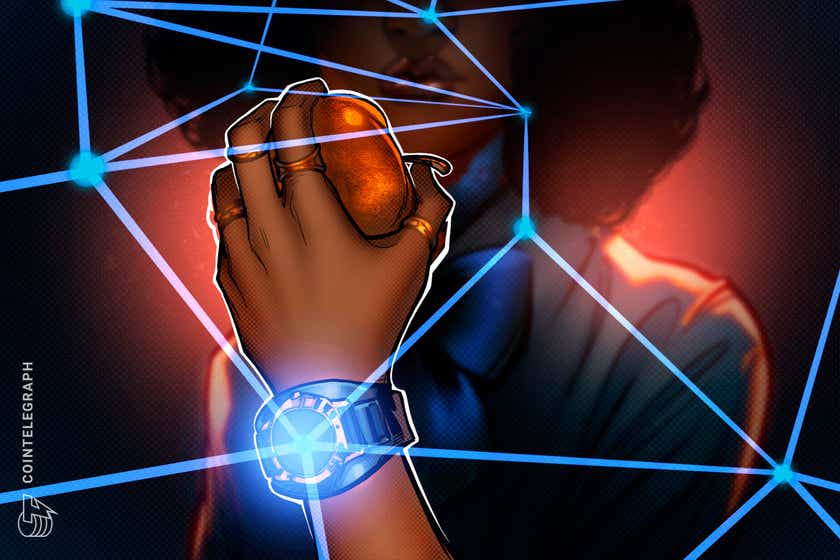Blockchain-enabled digital fashion creates new business models for brands

A “digital-first” model is disrupting the fashion sector, as blockchain technology shows advanced capabilities in Web3 e-commerce and sustainability.
Nonfungible tokens (NFT) may be disrupting the trillion-dollar fashion industry, but NFTs are just one piece of a much larger puzzle that is revolutionizing this sector. Rather, blockchain technology as a whole continues to be a game-changer for the fashion industry.
While blockchain-based supply chains served as some of the earliest use cases of how the technology could help detect fraudulent items, digital wearables being built on blockchain networks are now coming to play. Megan Kaspar, co-founder and managing director of Magnetic — a privately held crypto and blockchain investment and incubation firm — told Cointelegraph that digital fashion is a very powerful use case for blockchain technology. However, she noted that many brands remain unaware of the value that blockchain can provide in terms of creating new business models.
The rise of digital fashion and its impact
In order to explain the massive opportunities blockchain can bring to today’s fashion world, Kaspar noted that all brands will initially move to a “digital-first” model in the near future:
“This is where collections are created digitally first, whether in-house or outsourced to a company. The digital-first process reduces time, energy and capital, all of which are no longer required to preview collections prior to production. The digital collection can then be superimposed onto photos through digital tailoring.”
To put this in perspective, Kaspar was recently featured on the cover of the January issue of Haute Living. This was unique in the sense that it was the first fashion magazine cover in the United States to display digital luxury designer garments on a human. Additionally, the Haute Living cover is equipped with QR codes that generate augmented reality try-on functions, allowing readers to scan barcodes to see how each digital piece featured could look. The designs, which were created by Fendi and digitized by DressX, can then be purchased directly on the Fendi website.

While innovative from a marketing perspective, there are other benefits of digital-first fashion. For instance, Adrienne Faurote, fashion director at Haute Living, remarked in her feature story that “the days of shipping over 20 trunks of clothing across the globe” are gone. This is an important point to consider, especially as the COVID-19 pandemic has resulted in a number of supply chain issues, such as shipping containers getting delayed across the world.
It’s also important to note that a blockchain network is not required when it comes to digital-first models. Daria Shapovalova, co-founder of DressX, told Cointelegraph that while the Fendi garments worn by Kaspar on the cover of Haute Living are completely digital, they are not NFTs:
“With this first digital cover in the U.S., we aimed to promote digital fashion to a mainstream audience, making Fendi AR try-on capabilities available to everyone — free of charge. Releasing the items as NFTs, on the other hand, would mean that the digital assets and AR would only belong to the NFT holders, which would significantly limit the audience’s ability to interact with the digital garments.”
According to Shapovalova, while NFTs are capable of bringing many opportunities to the digital fashion industry, such as providing a sense of belonging and a scarcity effect, this was not what DressX intended to achieve with this specific campaign. Kamal Hotchandani, chief operating officer of Haute Media Group, added that the Haute Living cover demonstrates how mainstream publication features are moving to the digital landscape, with the rise of shoppable editorials and augmented reality (AR) try-on capabilities.
Yet when blockchain capabilities are applied to this mix, the benefits become far greater. For example, blockchain technology is enabling Web3 e-commerce between digital and physical items.
Justin Banon, co-founder of Boson Protocol — a decentralized commerce platform — told Cointelegraph that the company has developed a foundational base layer for Web3 that enables smart contracts to execute e-commerce transactions within virtual, metaverse environments. Due to the capabilities provided by smart contracts on Boson’s blockchain network, Banon said that trust issues that could potentially arise in a metaverse setting can be resolved:
“For example, if an individual entered a metaverse and came across another avatar that was selling a car, one may wonder how this transaction would be secure. Boson Protocol serves as the trust layer between the metaverse and the universe by enabling the sale of NFTs with encoded game theory that can then be redeemed for real-world items.”
Blockchain serving as a trusted layer between Web3 commerce transactions is critical here, especially as major labels such as Nike and Adidas set up stores in the metaverse. Digitizing items as NFTs becomes the next step required for selling goods in virtual environments, which bring about additional functionalities.
For instance, Kaspar explained that digital-first collections can be sold solely as NFTs and then later manufactured if a buyer desires to have the physical items: “Harnessing blockchain technology and NFTs affords production quantity, visibility of each garment and globally accessible for the first time in history. Limited-edition drops and on-demand manufacturing could easily be byproducts of Web3.”
Your unique RTFKT Punks Sneaker NFT gets you :
NFT 1/1 + 1 Pair of Physical to forge June 22nd
VXL Portrait 1/1 (airdropped later we removed double minting to ease the chain a bit)
Voxel sneakers files for MetaverseAll made from your Punk https://t.co/B4YOKI0dV4 pic.twitter.com/7vOX0mRRLr
— RTFKT Studios (@RTFKTstudios) May 11, 2021
Banon added that while 2021 focused primarily on brands selling NFT fashion, this year will see an increased push toward “digi-physical” or “phygitals.” According to Banon, this is when brands sell physical fashion items in Web3 ecosystems that are associated with NFT counterparts. “Think physical sneakers with an NFT wearable version as well,” said Banon. This was recently demonstrated by crypto fashion house RTFKT as the company collaborated with “CryptoPunks” to create 10,000 NFT sneakers. One custom sneaker pair was created for each “CryptoPunk” released and then given to its rightful owner to wear.
The transparency provided by a blockchain network is also beneficial. For example, Kaspar pointed out that limited-edition fashion drops appeal to certain consumers. As such, it’s possible to understand how many items truly exist across a blockchain network when they are sold as digitized NFTs. This was demonstrated recently when Dolce & Gabbana launched its nine-piece “Collezione Genesi” NFT collection.
Although the Fendi collection featured in Haute Living’s January 2022 issue was not NFTs, Natalia Modenova, co-founder of DressX, told Cointelegraph that nonfungible tokens will provide the next layer of utility within the fashion industry:
“NFTs maximize opportunities and open up new realms for self-expression and creativity. We compare NFTs to high-end fashion or haute couture because it provides a sense of belonging, a scarcity effect and a luxury feel, which would not otherwise be achieved in the digital world.”
How soon will digital-first fashion be adopted?
While digital-first models are capable of providing the fashion industry with a number of advantages, there are challenges that may hamper adoption. For instance, while it’s notable how realistic the digital Fendi collection appears on Kaspar, the amount of work required to create such an effect is massive.
To this point, Modenova shared that the process of digitizing garments is always dependent on the materials provided by the brand. “All nine Fendi outfits were digitized from photos, recreating the fabrics, patterns and silhouettes of the luxury garments in the 3D space from scratch,” Kaspar said, adding that all elements of fashion design — such as shape, color, space, form, texture, etc. — play a fundamental role in the digitization of garments to create a perfect visual design. As such, this process requires professionalism that may be difficult to obtain given that the space is still emerging.
Related: Unlocking utility is key for fashion brands launching NFTs in 2022
This challenge does not seem to be impacting the role that blockchain will likely continue to play in the fashion sector. Hotchandani remarked that moving forward, Haute Living plans to convert all the magazine’s covers into NFTs. “Our covers are pieces of art and content relevant to that moment in time, so I feel creating NFTs of our covers gives our art another expression and a permanent home on the blockchain.”
Modenova pointed out that the rise of the metaverse has resulted in “metafashion,” noting that digital assets that were once only used for gaming are now being designed to dress digital versions of humans:
“People from tech and gaming backgrounds quickly understand this, but now, the mainstream is starting to actively follow. This is a common pattern that arises when innovative products are launched. Wearables are the most natural extension of the metaverse and the most important pillar of the metaverse economy.”









